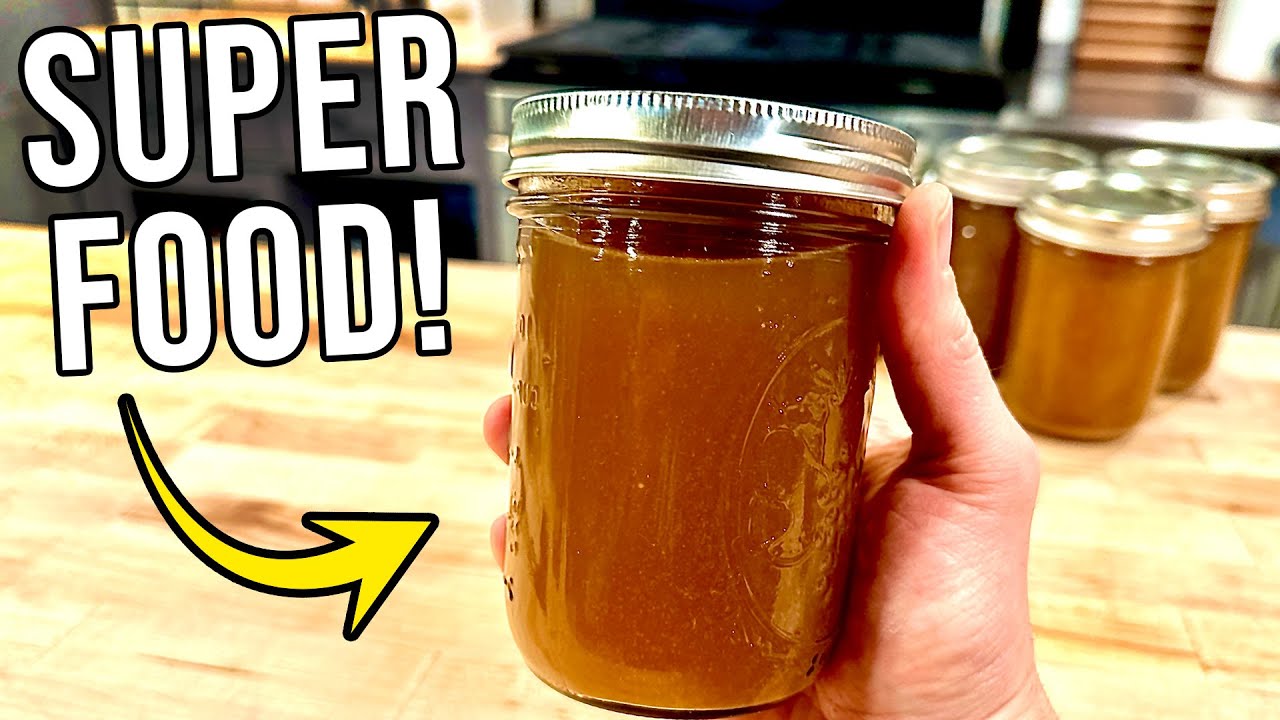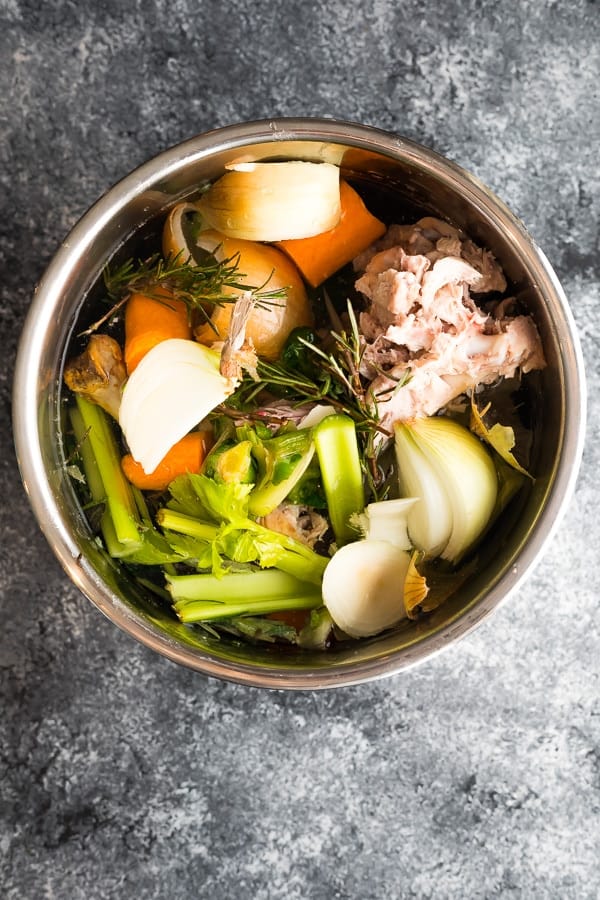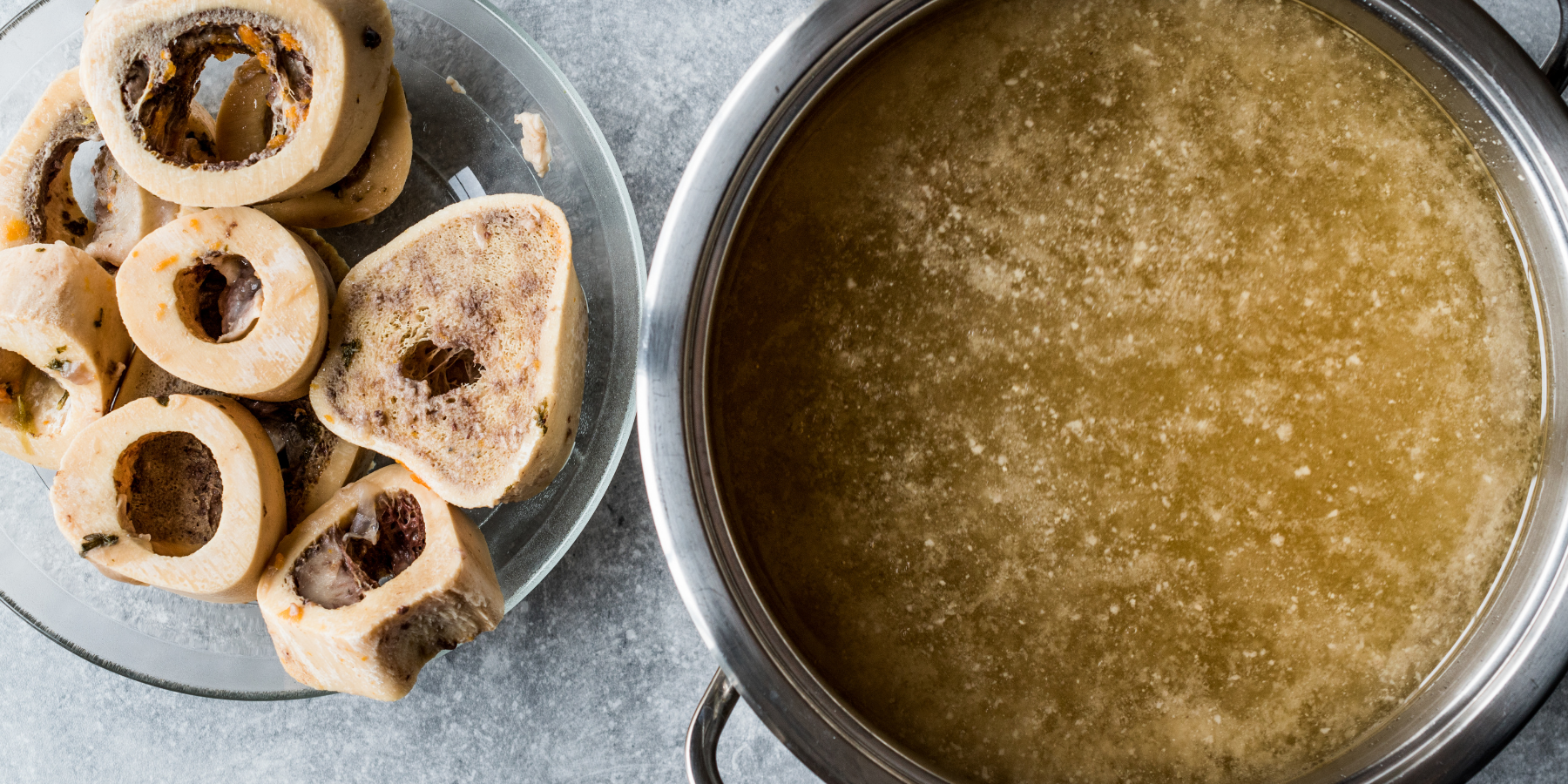
Imagine a kitchen filled with the comforting aroma of a simmering pot, rich with nutrients and flavor. Bone broth, a timeless staple in traditional cooking, is as simple to make as it is beneficial to your health.
From its ability to support gut health and strengthen joints to its versatility in countless recipes, learning how to craft bone broth at home unlocks a world of wellness and culinary possibilities.
What Is Bone Broth?
Bone broth is a slow-cooked liquid made by simmering animal bones and connective tissues along with vegetables, herbs, and acidic ingredients like vinegar. It’s simmered for long hours anywhere from 12 to 48 allowing nutrients like collagen, gelatin, amino acids, and minerals to infuse into the liquid. Make broth from scratchand you’ll experience all the benefits of the natural nutrients that are extracted from the bones during this lengthy process.
Unlike regular stock, which is primarily used for flavor in cooking, bone broth offers a broader range of health benefits. This makes it a favorite not just for chefs but also for people seeking natural remedies for digestion, joint health, and skin rejuvenation.
Why Make Bone Broth At Home?
Making bone broth at home offers advantages that store-bought options can’t compete with:
- Nutritional Control: Homemade broth lets you avoid the additives, preservatives, and excessive sodium often found in packaged options.
- Cost-Effective: Bones, often considered kitchen scraps, can be repurposed to make broth, saving money while reducing waste.
- Flavor Customization: Adjust the seasonings, herbs, and cooking time to suit your preferences.
- Sustainability: Using leftover bones from meals minimizes waste and makes the most of every ingredient.
How Is Bone Broth Different From Regular Broth Or Stock?
1. Cooking Time And Technique
The primary difference between bone broth and regular broth or stock lies in the cooking time.
- Bone Broth: Bone broth is simmered for a long time typically 12 to 48 hours allowing the collagen, gelatin, and minerals in the bones to fully dissolve into the liquid, resulting in a rich, nutrient-dense broth.
- Regular Broth: Broth is usually simmered for a much shorter time around 1 to 2 hours enough to extract flavor from meat and vegetables, but without breaking down the collagen in the bones.
- Stock: Stock is similar to broth but typically simmered for 3 to 4 hours. It’s made using bones (often roasted) and may or may not contain some meat. It focuses more on extracting the collagen and gelatin from the bones.
2. Ingredients Used
While all three liquids contain bones, the ingredients used for broth or stock differ slightly.
- Bone Broth: Bone broth is made primarily from bones, often with a small amount of meat attached. It also includes vegetables and aromatics, and a bit of vinegar (or another acid) to help extract minerals from the bones.
- Regular Broth: Broth is typically made with meat (sometimes including bones), vegetables, and herbs, but it does not always focus on extracting collagen.
- Stock: Stock is made from bones (usually with cartilage or connective tissue) and vegetables, with a focus on the gelatin from the bones. Unlike broth, stock is generally made without much meat, allowing it to produce a thicker, more gelatinous texture once cooled.
3. Nutritional Content
The nutritional profile of bone broth is far richer than that of regular broth or stock.
- Bone Broth: Because of the long simmering process, bone broth is high in collagen, gelatin, amino acids (like glycine and proline), and minerals such as calcium, magnesium, and phosphorus. These nutrients are beneficial for joint health, gut health, skin, hair, and nails.
- Regular Broth: While broth contains vitamins and minerals from the meat and vegetables, it does not extract the same level of collagen and gelatin as bone broth.
- Stock: Stock contains some gelatin, which gives it a slightly thicker consistency, but it is not as nutrient-dense as bone broth since it is cooked for a shorter time.
4. Flavor And Texture
The longer cooking time of bone broth gives it a richer, fuller flavor and thicker texture compared to broth or stock.
- Bone Broth: The extended simmering creates a deep, savory taste with a velvety, gelatinous texture that is noticeable once the broth cools.
- Regular Broth: Broth has a lighter, more delicate flavor and a thinner consistency. It is generally not as rich or filling.
- Stock: Stock has a thicker consistency than broth due to the gelatin, but it’s still not as rich and full-bodied as bone broth.
5. Health Benefits
The nutritional richness of bone broth contributes to its reputation as a health-boosting food.
- Bone Broth: Bone broth is considered a superfood due to its high concentration of collagen, amino acids, and minerals, which can support joint health, digestion, immune function, and skin elasticity.
- Regular Broth: While nutritious, broth lacks the collagen contentand extended nutritional benefits found in bone broth.
- Stock: Stock offers some benefits from gelatin but is not as rich in collagen or minerals as bone broth.
Types Of Bones To Use For Bone Broth
The type of bones you choose impacts the flavor, nutrition, and texture of your broth. Here’s a breakdown of the best bones to use:
- Beef Bones: Rich and hearty, they’re ideal for deep flavors. Look for marrow bones, knuckles, and oxtails.
- Chicken Bones: Mild and versatile. Use a mix of carcasses, wings, and feet (for extra gelatin).
- Pork Bones: Slightly sweeter in flavor, great for ramen or soups.
- Fish Bones: Lighter and more delicate, perfect for quick-simmered broths.
Pro Tip: Combine different types of bones for a more complex flavor profile.
Essential Ingredients For Bone Broth
- Bones: Start with clean, high-quality bones from organic or pasture-raised animals.
- Aromatics: Onion, garlic, celery, carrots, and leeks enhance the broth’s depth.
- Vinegar: Apple cider vinegar or lemon juice helps extract minerals from the bones.
- Herbs and Spices: Add bay leaves, thyme, peppercorns, or parsley stems for added complexity.
- Water: Use filtered water to prevent impurities from affecting the taste.
Step-by-Step Direction

How to Make Bone Broth At Home: EASY Step-by-Step Guide!
1. Prepare The Bones
The foundation of any great bone broth begins with properly prepared bones:
- Rinse the Bones: Place the bones in a large bowl or colander and rinse thoroughly under cold water. This removes blood, impurities, and excess surface debris that can cloud the broth or give it an undesirable flavor.
- Roast the Bones: Preheat your oven to 400°F (200°C). Spread the bones out on a baking sheet in a single layer. Roast them for 20-30 minutes, flipping halfway through, until they develop a deep golden-brown color. This step is crucial for intensifying the flavor of beef or pork broths, as the roasting process caramelizes the natural sugars in the bones and meat scraps. For lighter broths, such as chicken or fish, roasting is optional but recommended for a richer taste.
2. Add Ingredients To The Pot
Once the bones are prepared, it’s time to assemble everything in your pot or slow cooker:
- Place the Ingredients: Add the roasted bones to your stockpot, slow cooker, or pressure cooker. Arrange your vegetables and aromatics around the bones. Common choices include onions, garlic, carrots, celery, and fresh herbslike thyme or bay leaves.
- Add an Acid: Pour in 1-2 tablespoons of apple cider vinegar or lemon juice. The acid helps break down the collagen and minerals in the bones, extracting their nutrients into the broth.
- Fill with Water: Add enough filtered water to completely cover the bones and ingredients by about 2 inches. Avoid overfilling, as the broth needs room to simmer without boiling over.
3. Simmer Slowly
- Chicken Bones: Simmer for 12-24 hours to extract maximum nutrients.
- Beef or Pork Bones: Allow 24-48 hours for the dense, marrow-rich bones to break down fully.
- Fish Bones: These are more delicate and require only 6-8 hours to produce a flavorful broth.
- Bring to a Boil: Place the pot on the stove and heat it over medium-high heat until the liquid begins to boil.
- Reduce to a Simmer: Immediately lower the heat to maintain a gentle simmer. The surface should produce occasional small bubbles rather than a rolling boil. This prevents the broth from becoming cloudy and preserves its delicate flavors.
Cooking Time
- Simmer for 12-24 hours to extract maximum nutrients.
- Beef or Pork Bones: Allow 24-48 hours for the dense, marrow-rich bones to break down fully.
- Fish Bones: These are more delicate and require only 6-8 hours to produce a flavorful broth.
4. Skim The Foam
During the initial stages of simmering, you’ll notice foam or scum rising to the surface:
- Why Skim?: This foam contains impurities and proteins that can affect the clarity and taste of the broth. Removing it ensures a cleaner, more refined flavor.
- How to Skim: Use a spoon or a skimmer to gently remove the foam from the surface. Do this every 30-60 minute for the first few hours of simmering.
5. Strain The Broth
Once the cooking process is complete, it’s time to separate the liquid from the solids:
- Set Up a Strainer: Place a fine-mesh sieve or cheesecloth over a large bowl or pot.
- Pour the Broth: Carefully ladle or pour the broth through the strainer to remove bones, vegetables, and other solids. If using a cheesecloth, you can double-layer it for extra clarity.
- Optional Step: For an even clearer broth, strain it a second time. This step is particularly useful if you plan to use the broth as a base for delicate soups.
6. Cool And Store
- Cool the Broth: Allow the strained broth to cool at room temperature for about 30 minutes. To speed up cooling, place the pot or container in an ice bath.
- Skim Fat (Optional): Once cooled, a layer of fat may form on the surface. You can leave it as a protective seal for storage or skim it off for a lighter broth. A fat separator can make this step easier.
- Transfer to Containers: Pour the cooled broth into airtight jars or containers. For easy portioning, consider using silicone molds or ice cube trays.
- Refrigerate or Freeze: Store in the refrigerator for up to 5 days or freeze for up to 6 months. When freezing, leave some space at the top of the container to allow for expansion.
How To Use Bone Broth
Bone broth is one of the most versatile ingredients you can have in your kitchen. Its rich flavor and nutrient-dense profile make it a valuable addition to a variety of dishes. Here are some detailed ways to use bone broth effectively:
1. Drink It As A Warm, Nourishing Beverage
Bone broth is a comforting and nutrient-packed drink, perfect for starting your day or as a mid-afternoon pick-me-up.
- Why It Works: The warm liquid is soothing for digestion, and the high collagen content supports gut health and skin elasticity.
- How to Enjoy It: Heat the broth on the stove and season with a pinch of sea salt, black pepper, or herbs like thyme and parsley. For added flavor, mix in a splash of lemon juice, a knob of ginger, or a dash of turmeric.
2. Use It As A Base For Soups, Stews, And Sauces
Bone broth serves as an excellent foundation for creating rich, flavorful dishes.
- In soups: Replace water or plain stock with bone broth in recipes like chicken noodle soup, vegetable soup, or miso soup.
- In stews: Use bone broth as the liquid base for hearty stews, adding depth to dishes like beef bourguignon or chicken pot pie.
- In sauces: Reduce bone broth on the stove to create a flavorful base for gravies, demi-glace, or pan sauces for roasted meats.
3. Cook Grains Like Rice Or Quinoa In It For Added Flavor
Replace water with bone broth when cooking grains to elevate their taste and nutritional value.
- Rice: Substitute bone broth for water in recipes for pilafs, risottos, or even plain steamed rice.
- Quinoa: Use bone broth to cook quinoa, enhancing its flavor for salads or as a side dish.
- Other grains: Try cooking barley, farro, or bulgur in bone broth for a hearty and nutritious addition to your meals.
4. Incorporate It Into Gravies Or As A Deglazing Liquid
Bone broth is a fantastic tool for enhancing the flavor of sauces and gravies.
- Gravies: Use bone broth as the base for making pan gravies to accompany roasted meats or mashed potatoes.
- Deglazing: After cooking meats in a pan, pour a small amount of bone broth into the pan to deglaze it. Scrape up the flavorful browned bits, reduce the liquid, and use it as a quick sauce for your dish.
Common Mistakes To Avoid
1. Using Too Much Water
One of the most common mistakes when making bone broth is using too much water. While it’s essential to cover the bones and ingredients, adding excessive water dilutes both the flavor and the nutrients of the broth.
- Why It Matters: Overloading the pot with water stretches the flavors too thin, leaving you with a weak and bland broth. Additionally, the nutrients extracted from the bones become less concentrated, reducing the health benefits.
- How to Avoid It: Use just enough water to cover the bones and vegetables by about 1-2 inches. As the broth simmers and reduces, you can add small amounts of water if needed to keep the bones submerged. Avoid topping off the pot excessively.
2. Boiling Instead Of Simmering
Another common mistake is boiling the broth instead of letting it simmer gently. Boiling leads to rapid agitation, which can break down fats and proteins unevenly.
- Why It Matters: Boiling produces a cloudy broth with a gritty texture. It also disrupts the slow extraction process, preventing the flavors and nutrients from fully developing.
- How to Avoid It: After bringing the liquid to a boil, immediately lower the heat to maintain a gentle simmer. A proper simmer shows occasional bubbles rising slowly to the surface, not a rolling boil. Patience is key to achieving a clear and flavorful broth.
3. Skipping Vinegar
Vinegar plays a crucial role in the bone broth-making process, yet some people skip this step. Adding an acid like vinegar or lemon juice helps break down the collagen and minerals in the bones, allowing them to infuse into the broth.
- Why It Matters: Without vinegar, you miss out on extracting vital nutrients like calcium, magnesium, and phosphorous. This reduces the broth's nutritional value, especially its bone-building and gut-healing properties.
- How to Avoid It: Add 1-2 tablespoons of apple cider vinegar, white vinegar, or lemon juice to the pot before simmering. Let the bones sit with the vinegar and water for 20-30 minutes before applying heat. This helps maximize nutrient extraction during cooking.
4. Neglecting To Skim Foam
During the initial simmering phase, impurities from the bones and meat rise to the surface as foam or scum. Ignoring this step can negatively affect the taste and appearance of the broth.
- Why It Matters: If left untouched, the foam can introduce off flavors and a cloudy appearance to your broth. These impurities include blood and proteins that don’t add value to the final product.
- How to Avoid It: Use a spoon, skimmer, or ladle to remove the foam during the first 1-2 hours of simmering. Check the surface every 30-60 minutes and skim as needed. While it won’t ruin your broth if you forget once or twice, consistently skimming leads to a cleaner, more refined end product.
Health Benefits Of Bone Broth
1. Promotes Gut Health
Bone broth is rich in gelatin, a substance that helps repair the lining of the digestive tract. This is particularly beneficial for those with conditions like leaky gut syndrome, where the gut lining becomes permeable, allowing toxins to enter the bloodstream.
Gelatin also helps retain water in the digestive system, creating a soothing and protective environment for gut bacteria to thrive, leading to improved digestion and reduced gut-related discomfort. For individuals managing their sodium intake, opting for a low-sodium brothcan provide these benefits without the extra salt, making it a healthier choice for sensitive diets.
2. Supports Joint Health
The collagen, glucosamine, and chondroitin in bone broth are essential for maintaining healthy joints. Collagen helps repair and rebuild cartilage, the tissue that cushions joints, while glucosamine and chondroitin reduce inflammation and improve mobility. These compounds are particularly helpful for people with arthritis or those looking to prevent joint deterioration.
3. Boosts Skin, Hair, And Nail Health
Collagen, the primary protein found in bone broth, is a building block for healthy skin, hair, and nails. Consuming bone broth regularly can improve skin elasticity, reduce wrinkles, and keep skin hydrated. Additionally, it strengthens hair and nails, making them less prone to breakage, and supports the regeneration of skin cells for a youthful appearance.
4. Strengthens Bones And Teeth
Bone broth is a natural source of essential minerals such as calcium, magnesium, and phosphorus, all of which are critical for strong bones and teeth. These nutrients are extracted during the slow cooking process, making them bioavailable and easy for the body to absorb. This can help maintain bone density, prevent osteoporosis, and support dental health.
5. Supports Immune Function
Bone broth contains amino acids like arginine, glutamine, and cysteine, which play a vital role in supporting the immune system. These compounds help reduce inflammation and promote the production of white blood cells, which are key to fighting infections. Warm bone broth can also soothe a sore throat and act as a comforting remedy during illnesses.
6. Improves Sleep Quality
Glycine, an amino acid found abundantly in bone broth, has calming effects on the brain and nervous system. Consuming bone broth before bed can improve sleep quality by promoting relaxation and reducing anxiety. Glycine also helps regulate body temperature, making it easier to fall asleep and stay asleep.
7. Enhances Muscle Recovery
Bone broth is packed with amino acids and proteins that are essential for muscle repair and recovery. This makes it particularly beneficial for athletes or individuals recovering from physical injuries. The collagen and gelatin in bone broth support the healing of connective tissues, while the proteins contribute to the repair and growth of muscle fibers.
8. Reduces Inflammation
Chronic inflammation is a leading cause of various health issues, including arthritis, heart disease, and autoimmune conditions. Bone broth contains anti-inflammatory compounds like glucosamine and amino acids, which help reduce inflammation in the body. Regular consumption can alleviate joint pain and promote overall long-term health.
9. Aids In Weight Management
Bone broth is low in calories but high in nutrients, making it a satisfying addition to a weight-loss or maintenance plan. Its high gelatin content helps you feel full for longer, reducing hunger and the likelihood of overeating. By providing essential nutrients, it supports healthy metabolism and energy levels without adding excess calories.
10. Detoxifies The Body
Bone broth supports the liver’s natural detoxification processes through the amino acid glycine. Glycine helps the liver eliminate toxins and produce bile, which aids in digestion and the removal of waste. By supporting the body’s detox pathways, bone broth can enhance overall health and reduce the toxic burden on the body.
FAQs
How Long Should Bone Broth Simmer?
The simmering time depends on the type of bones used. Chicken bones typically require 12-24 hours, while beef or pork bones benefit from 24-48 hours to fully extract nutrients. Fish bones are more delicate and only need 6-8 hours.
Can I Reuse Bones For Multiple Batches Of Broth?
Yes, bones can be reused for a second batch, but the broth will be less flavorful and nutrient dense. Adding fresh aromatics and a splash of vinegar can help extract remaining nutrients in subsequent batches.
Do I Need To Roast The Bones Before Making Broth?
Roasting the bones is recommended, especially for beef or pork, as it enhances the broth’s flavor by caramelizing the natural sugars in the bones. For lighter broths like chicken or fish, roasting is optional but adds depth to the flavor.
What’s The Best Way To Store Bone Broth?
Store bone broth in airtight containers in the refrigerator for up to 5 days. For longer storage, freeze it in portions using ice cube trays, silicone molds, or freezer-safe containers. Frozen broth can last up to 6 months.
What Are The Best Bones To Use For Bone Broth?
The best bones depend on your flavor and nutritional preferences. Beef marrow bones, knuckles, and oxtails are great for rich broth. Chicken carcasses, wings, and feet produce a lighter broth with high gelatin content. Fish heads and bones create a delicate broth perfect for seafood-based dishes.
Conclusion
Crafting bone broth at home is more than just a cooking technique, it’s an opportunity to nourish your body and elevate your meals. With just a few simple ingredients and a bit of patience, you can create a nutrient-rich broth that enhances your health and adds depth to your favorite dishes. Start your journey with this timeless recipe and enjoy the countless benefits it brings to your table and your well-being.


